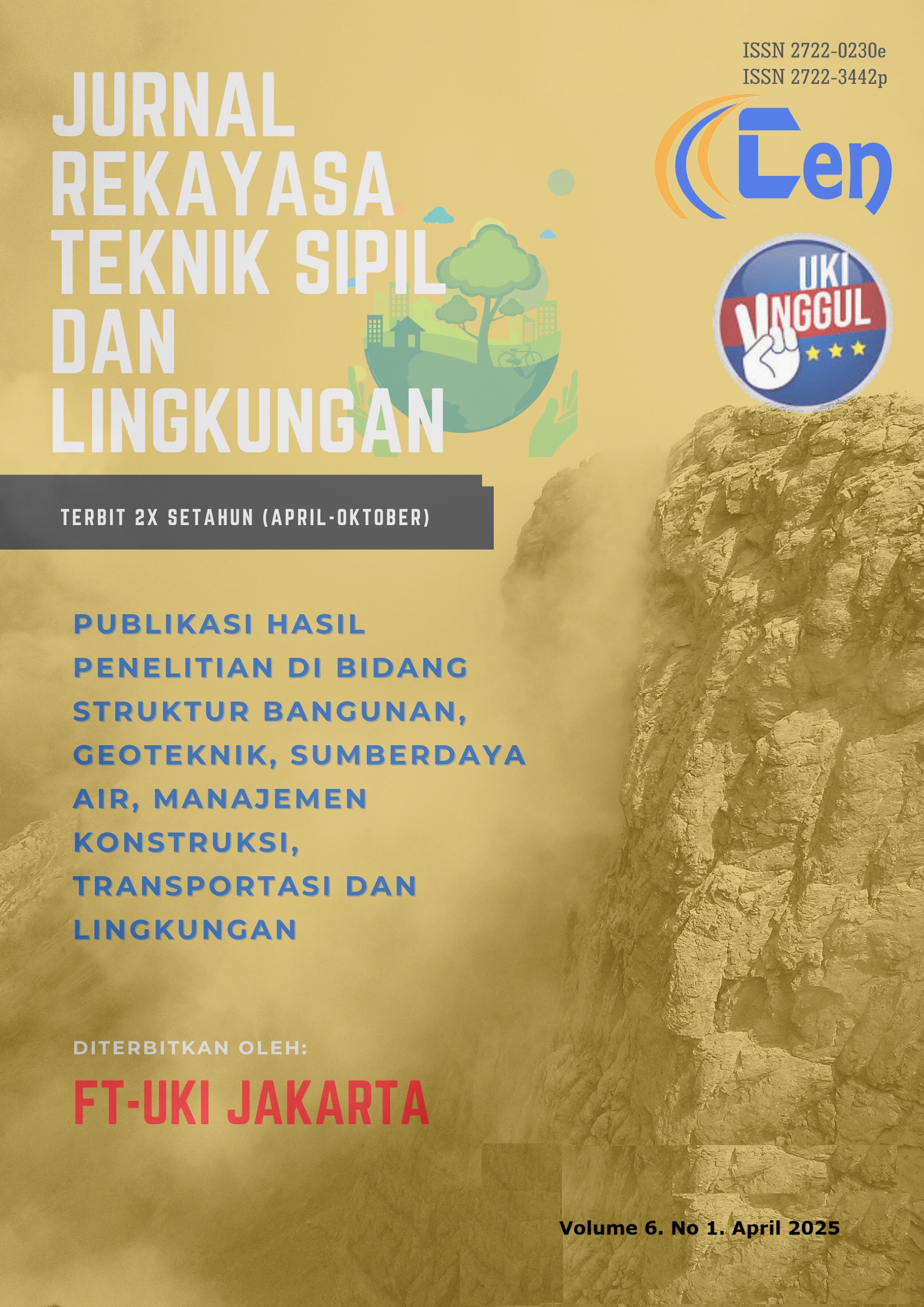ANALISIS PERBANDINGAN STABILITAS LERENG PADA AREA KARST (STUDI KASUS GIRIMULYO, KULON PROGO)
Keywords:
FEM, LEM, PLAXIS 2D, Slope/W, SFAbstract
Girimulyo District, Kulon Progo, is famous for its karst landscape, making it one of the tourist destinations. This location is mainly composed of easily soluble rocks such as limestone, dolomite, gypsum, and rock salt, making it very susceptible to landslides, thus requiring a comprehensive slope stability analysis to reduce the risk of landslides that impact residential areas, access roads, and tourist locations. This study evaluated slope stability using the Limit Equilibrium Method (LEM) and the Finite Element Method (FEM). The slope at the research location consists of a layer of silt on the surface and limestone at a depth of 9 meters. Slope modeling was carried out in static and pseudo-static conditions by combining horizontal seismic coefficients derived from SNI 1726 (2019). The results showed that most LEM methods, except the Fellenius method, had higher SF than the FEM method. All methods showed that the slope in the static condition is stable with a safety factor (SF) ≥ 1.25, while in the pseudo-static condition, all methods are considered unstable (SF ≤ 1.07). Among the LEM approaches, the Fellenius (1936) method showed the lowest SF, which is in accordance with previous studies, where this method is the most conservative and suitable for circular slip surfaces only. Meanwhile, the Bishop (1955) and Morgenstern-Price (1965) methods are the most recommended in this study because they accommodate circular and non-circular slip surfaces. The SF results are 2% higher than the FEM results. These results show the importance of choosing the proper analysis method for landslide-prone karst terrain such as Girimulyo.
Keywords: FEM; LEM; PLAXIS 2D; slope/W; SF
References
Agniy, R. F., Septianingrum, R. S., Adinugraha, A. S., Alghozali, Q., Aditya, B., Cahyadi, A., & Adji, T. N. (2019). Analysis of Cavities Characteristics in the Semar—Kiskendo Caves System, Jonggrangan Karst Area, Kulon Progo, Indonesia. E3S Web of Conferences, 125, 01016. https://doi.org/10.1051/e3sconf/201912501016
Akhlaghi, T., & Nikkar, A. (2014). Evaluation of the pseudostatic analyses of earth dams using Fe simulation and observed earthquake-induced deformations: Case studies of Upper San Fernando and Kitayama dams. ScientificWorldJournal. https://doi.org/10.1155/2014/585462
Aryal, K. P. (2006). Slope Stability Evaluations by Limit Equilibrium and Finite Element Methods. Norwegian University of Science and Technology.
Bardhi, D. (2021). Slopes Analyses—Case Study, Slope Stability of Bypass Project. European Journal of Engineering and Formal Sciences, 4(2), 34. https://doi.org/10.26417/466qfl71z
Bishop, A. (1955). The use of slip circle in the stability analysis of slopes. Geotechnique, 5(1), 7–17.
BNPB. (2017). Badan Nasional Penanggulangan Bencana (BNPB). InaRISK. https://inarisk.bnpb.go.id/
BPS. (2024). Jumlah Penduduk Menurut Kecamatan dan Jenis Kelamin. Jumlah Penduduk Menurut Kecamatan Dan Jenis Kelamin. https://kulonprogokab.bps.go.id/id/statistics-table/2/NDQ0IzI=/jumlah-penduduk-menurut-kecamatan-dan-jenis-kelamin--tahun-2020.html
Burman, A., Acharya, S. P., Sahay, R. R., & Maity, D. (2015). A Comparative Study Of Slope Stability Analysis Using Traditional Limit Equilibrium Method And Finite Element Method.
Fellenius, W. (1936). Calculations of the Stability of Earth Dams. Proceedings of the 2nd Congress on Large Dams, 4, 445.
Fitri, S. N., & Wahyuni, F. (2022). Safety Factors Investigation Based on FEM and LEM Approach in Toll Road Embankment Slope. Civil Engineering and Architecture, 10(5), 1948–1966. https://doi.org/10.13189/cea.2022.100518
Google Earth. (2022). Research Location (2022nd ed.) [Map]. Google Earth.
Jianti, M. (2021). Pemetaan Tingkat Kerawanan Bencana Tanah Longsor Pada Kawasan Lahan Terbangun Menggunakan Metode Berjenjang Tertimbang Di Sebagian Kabupaten Kulon Progo (Studi Kasus Kecamatan Samigaluh, Girimulyo, dan Kokap) [Univesitas Gadjah Mada]. http://etd.repository.ugm.ac.id/
Look, B. (2007). Handbook of geotechnical investigation and design tables. https://doi.org/10.1201/9780203946602
Maryanto, S. (2013). Sedimentologi Batugamping Formasi Jonggrangan Di Sepanjang Lintasan Gua Kiskendo, Girimulyo, Kulonprogo. 23(2).
Memon, M. Y. (2018). A Comparison Between Limit Equilibrium and Finite Element Methods for Slope Stability Analysis. Unpublished. https://doi.org/10.13140/RG.2.2.16932.53124
Morgenstern, N. R., & Price, V. (1965). The analysis of the stability of general slip surfaces. Geotechnique, 15(1), 79–93.
PLAXIS. (2012). PLAXIS Manual [Manual]. Delft University of Technology.
Remesh, P., Sha, R., Mohan, S., & Paul, M. M. (2023). Slope Stability Analysis Using Geostudio And Plaxis 2d Software: A Comparative Study. 10(10).
Santie, P. A. W., Wilopo, W., & Faris, F. (2024). Slope Stability Analysis Using Electrical Resistivity Tomography and Limit Equilibrium Method: A Case Study from Girimulyo, Kulon Progo. Journal of Applied Geology, 9(1), 37. https://doi.org/10.22146/jag.97467
Sudinda, T. W. (2020). Analis Kestabilan Lereng Pada Lokasi Tambang Batubara Tanah Laut Kalimantan Selatan.
Wubalem, A. (2022). Comparison of General Limit Equilibrium Methods for Slope Stability Analysis. https://doi.org/10.20372/EJNCS/EA.2022.18
Downloads
Published
How to Cite
Issue
Section
License
Copyright (c) 2025 Anisa Nur Amalina, Azmi Aufa Ifthikar

This work is licensed under a Creative Commons Attribution 4.0 International License.
Hak Cipta atas Tulisan Karya Ilmiah
Bersama dengan ini saya sebagai penulis utama menyatakan bahwa paper yang saya kirimkan untuk dipublikasikan melalu Jurnal Rekayasa Teknik Sipil dan Lingkungan adalah benar merupakan hasil orisinil Tulisan Karya Ilmiah yang merupakan hasil penelitian/kajian yang saya lakukan dan belum pernah dipublikasikan pada penerbit Jurnal ilmiah lain di Indonesia.
Jika di kemudian hari ternyata ditemukan bukti adanya hal-hal yang tidak sesuai dari pernyataan diatas maka saya bersedia menerima konsekuensi yang diberikan oleh Dewan Redaksi Jurnal Rekayasa Teknik Sipil dan Lingkungan serta paper yang telah diterbitkan akan DIBATALKAN dan dinyatakan sebagai hasil karya PLAGIASI.









